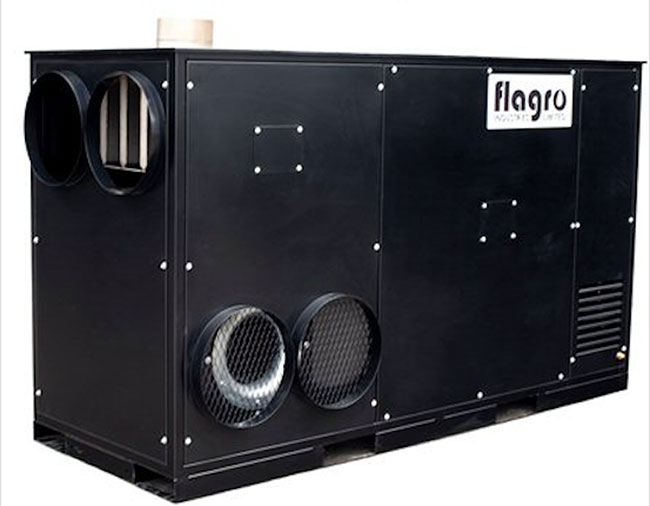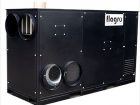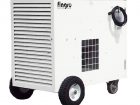
Natural gas construction heat: cheaper, easier but not always available
By Gal Power
Features Tech tips education technologyThere are a wide range of natural gas heaters on the market today. They can be open flame, make-up air or indirect-fired units that can range from 100,000 BTUs to 4.5 million BTUs and CFMs are variable depending on the type of unit.

The main differences between models are typically the complexity of control systems and the construction materials used in these units. The more features and options, such as units with remote thermostats that can be monitored remotely, the higher also the price. Things to also consider when purchasing natural gas units are warranty, availability of replacement parts and manufacturer support.
The most common natural gas heaters are open flame “salamander” heaters along with 750,000-BTU indirect-fired heaters, however, there are enough styles of natural gas heaters that there is a size for almost any application. Salamander heaters are most often found at construction sites and date as far back as 1915 when they were created to provide warmth to construction workers in inclement weather.
Why use natural gas?
The most common attraction for using natural gas is usually price and the constant availability of a fuel source. According to Union Gas, a natural gas supplier in Ontario, natural gas can cost up to 60 per cent less than propane or electricity. Union Gas also says natural gas produces a drier heat than other fuels, making it more attractive for drying and curing construction materials.
There is no worrying about calling for and organizing fuel refills or the tank emptying out, so there is one less thing to manage. Sometimes the customer can pay for their own gas consumption and the contractor heating the building just supplies the equipment, so the customer takes care of the gas. These arrangements often make natural gas an attractive option for the customer.
Installation of natural gas heaters
To hook up a natural gas heater, a qualified gas fitter (G1 licence) and an electrician to make the connections must be used. Fuel pressure needs to be confirmed, as well as voltage and a combustion analysis to determine proper fuel/air ratios. This being said, rental store staff can be trained in certain areas. ROT training can offer your staff the ability to work on heaters up to certain BTUs and also to be trained on start-up and maintenance of the units. However, it is important to note that for a full install, a licensed gas fitter and electrician are required. For questions related to install, contact your local regulatory body for clarification on what the regulations are as they can vary by province throughout Canada.
One limitation of natural gas is that the site must be ready to receive the line before service can be put in. For instance, in Ontario, Union Gas requires the building foundation to be poured and backfilled, with the soil compacted to within six inches of final grade. The gas meter location must be marked on the foundation with the correct clearances from building openings. There has to be a clear route, free of debris, machinery and construction materials, from the meter to the property line in order to install the line.
Safety considerations
As with all types of heating equipment, it is imperative that the manufacturer’s instructions be followed closely and that no modifications be made to the equipment without checking with the manufacturer first. Ensure that all local and national codes and regulations are followed (for example, from the Technical Standards and Safety Authority, which is the regulatory body in Ontario) and ensure you are in compliance with the most recent code updates.
Using natural gas does eliminate the need to handle and replace fuel and fuel tanks, reducing the chances of an accident while refuelling. The lack of spare and empty containers on the job site reduces clutter and fire hazards.
Maintaining natural gas heaters
Natural gas heaters need to be kept clean from debris and need to be well maintained for optimum performance. Bearings need to be greased on a regular basis, belts adjusted and hardware (screws, nuts, bolts) tightened. It is also important to carry out electrical system inspections and clean and test the burners on a regular basis.
Heaters that are switchable between propane and NG
Today, there are heaters that have flexible fuel capacities between both propane and natural gas. Changing fuels in these units is fairly simple. As there are very few drawbacks, these units are good options that give rental stores the flexibility to adhere to their customer’s needs.
Obviously, natural gas is not in common use everywhere in the country and therefore many construction sites will not have service. But where there is service, it can be a less expensive and convenient way to heat a construction site.
Who ya gonna call?
Natural gas regulatory authorities, by province:
- B.C. – BC Safety Authority • safetyauthority.ca
- Alberta – Alberta Municipal Affairs • municipalaffairs.alberta.ca
- Saskatchewan – Gas and Electrical Licensing • saskatchewan.ca
- Manitoba – Inspection and Technical Services Manitoba • firecomm.gov.mb.ca
- Ontario – Technical Standards and Safety Authority • tssa.org
- Quebec – Commission de la construction du Quebec • ccq.org
- New Brunswick – Justice and Public Safety • gnb.ca
- Nova Scotia – Department of Labour and Advanced Education • novascotia.ca/lae
- P.E.I. – Natural gas not available
- Newfoundland and Labrador – Natural gas not available
GAL Power offers specialized power and temperature control solutions from nine locations across Ontario and Quebec.
Print this page


Leave a Reply